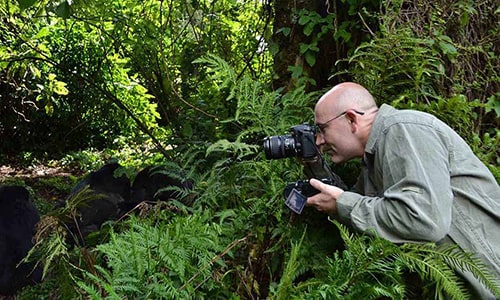Photographing Mountain Gorillas in the Wild
 Photographing mountain gorillas is one the best experiences in the wild as it given tourists opportunities to make the trip visibly memorable. To photography mountain gorilla, ensure that you have a high lens camera that doesn’t disappoint. The Gorilla Habituation Experience is one of the most ideal wildlife photography encounters in the world as it offers adequate time to capture the best shot. But still taking photographs of gorillas may be challenging due to prohibited flash light condition as well as the restricted distance between the gorillas and you.
Photographing mountain gorillas is one the best experiences in the wild as it given tourists opportunities to make the trip visibly memorable. To photography mountain gorilla, ensure that you have a high lens camera that doesn’t disappoint. The Gorilla Habituation Experience is one of the most ideal wildlife photography encounters in the world as it offers adequate time to capture the best shot. But still taking photographs of gorillas may be challenging due to prohibited flash light condition as well as the restricted distance between the gorillas and you.
As a photographer keen of taking the best mountain gorilla photography, you should ensure that you are well prepared as much as possible to get the nicest photos. Ensure that your camera batteries are fully charged and you have plenty of storage space on the memory cards. carry with you waterproof bags or covers for your camera or phones as the rain forest weather conditions are not predictable.
The choice of a camera you come with is completely up to you but make sure its the best with a high resolution. Flash photography is not permitted , so try to disable you camera flash or mobile phone prior to accessing your gorilla family.
The time you are with the gorillas is valuable so you should plan your shots instead of shooting excitedly. We suggest that you find a balance between engrossing this unbelievable experience and taking photographs of these captivating creatures. You should not spend the whole time looking through the lenses of your camera but also focus on the experience as you photograph the gorillas.
Mountain Gorilla Photography Tips – Getting the Best Outcome on Mountain Gorilla Photography
Taking mountain gorilla photos is a once-in-a-lifetime, bucket List topping experience. Below are some insights that will assist you in making the most and getting the best of this exhilarating wild encounter. It feels like an exceptional privilege coming across Mountain Gorillas. With a few endangered mountain gorillas left in the wild today, you need to have a rare opportunity of seeing them in their unique nature. The world’s remaining mountain gorillas are found in three countries straddling four national parks. Mountain Gorilla habitats in Africa include Bwindi Impenetrable National Park and Mgahinga Gorilla National Park in Uganda, Volcanoes National Park in Rwanda and Virunga National Park in Congo. To get the best Mountain Gorilla Photography opportunity, visit these animals in Bwindi National Park, which is habitat to the largest group of gorillas. It is believed that Bwindi forest has almost half the remaining estimated over 1000 primates left in the world today. Encountering gorillas in Bwindi is a justly awe-inspiring experience. Many visitors who participate in photographing mountain gorillas asserts that it’s the most passionately challenging and rewarding wildlife photo shoot experience. The friendly sight one gets from the endangered species is something that is unforgettable especially when you have perceptive photos to retrieve from your camera back home.
The Ultimate Guide To Photographing Mountain Gorillas on Trekking Adventures
Photographing gorillas in their natural habitat is a truly unforgettable experience. With the right techniques and preparation, you can capture stunning images that highlight the beauty, strength, and personality of these magnificent creatures. The following are some detailed tips to enhance your gorilla photography adventure:-
Get Low for Intimate Gorilla Shots
Positioning yourself at or below the gorilla’s eye level creates a more personal and emotional connection in your photographs. This angle invites viewers to engage directly with the gorilla, feeling as though they’re sharing a moment face-to-face. By lowering your perspective, you emphasize the animal’s presence and strength while avoiding a dominating, overhead viewpoint. Always move gently to maintain the gorilla’s comfort and your safety.
Use a Wide Aperture for Impactful Photos
A wide aperture, such as f/2.8 or f/5.6, is perfect for isolating the gorilla from its often dense and busy surroundings. This setting creates a shallow depth of field, blurring the background into a soft bokeh that draws attention to the gorilla as the clear and detailed focal point. Proper focus on the gorilla’s face ensures sharpness, enhancing the subject’s prominence while simplifying the image composition.
Focus on Their Eyes for Beautiful Catchlights
The eyes are crucial in creating emotional depth in your photos. Capturing light reflections, or catchlights, in the gorilla’s eyes adds a lifelike sparkle and draws viewers into their expressions. Use spot focusing to keep the eyes sharp, adjusting your ISO or aperture for clarity if lighting is dim. Seek naturally illuminated moments when light filters through foliage to enhance the gorilla’s gaze.
Simplify the Background to Avoid Distractions
A clean background helps keep the gorilla as the center of attention. By repositioning yourself or altering your angle, you can eliminate clutter and frame the subject naturally with elements like leaves or tree trunks. In post-processing, further simplify by cropping or blurring distractions. This technique ensures that nothing competes with the gorilla for the viewer’s focus.
Use a Long Telephoto Lens for Detailed Shots
A telephoto lens, such as a 70–200mm or 100–400mm, allows you to capture intricate details without getting too close, maintaining both safety and respect for the gorillas’ comfort. This distance lets you photograph intimate moments unobtrusively. To counteract camera shake, especially in low-light jungle conditions, stabilize your setup with a monopod or tripod.
Respect Lighting Challenges in the Jungle
The jungle’s mix of bright sunlight and deep shadows can make proper exposure tricky. Manual or aperture priority modes give you greater control over your settings, while spot metering ensures your subject is correctly exposed. Pay attention to your histogram to avoid overexposing bright areas or losing detail in the gorilla’s dark fur, adapting your settings as light conditions change.
Anticipate and Capture Behavior
Gorillas’ rich social interactions and expressive gestures make them captivating subjects. Observe their movements and expressions closely to predict memorable moments, such as playful juveniles or nurturing parents. Burst mode can be invaluable for capturing action sequences, allowing you to select the most compelling frame from a series.
Dress and Pack Appropriately
Comfort and preparedness are key to a successful trekking and photography experience. Wear neutral-colored, moisture-wicking clothes to blend into the environment and stay dry in humid conditions. Protect your gear with rain covers and ensure you carry enough batteries and memory cards, as trekking can last for hours in unpredictable weather.
Respect Wildlife and Follow Guidelines
Adhering to trekking guidelines is essential for both your safety and the gorillas’ well-being. Always maintain a respectful distance of at least 7 meters to prevent stress or disease transmission. Use natural light or adjust your camera’s ISO settings instead of flash to avoid disturbing the gorillas, ensuring a responsible and enjoyable encounter.
Take Time to Enjoy the Experience
While capturing breathtaking photos is rewarding, it’s equally important to pause and soak in the unique privilege of observing gorillas in their natural habitat. Setting your camera aside occasionally allows you to fully appreciate the majesty of these creatures and the incredible environment they inhabit, making the experience truly unforgettable.
By following the above tips and practicing patience, you will not only capture breathtaking images of gorillas but also create unforgettable memories of your trekking adventure.
The Importance of Photographing Mountain Gorillas in the Wild in Uganda, Rwanda and Congo
Mountain gorillas are among the most majestic and endangered species in the world. Found only in the dense forests of Uganda, Rwanda, and the Democratic Republic of Congo, these great apes have captivated wildlife enthusiasts, researchers, and photographers alike. Capturing their essence through photography is not just an artistic endeavor but also a vital activity for conservation, education, and tourism.
Raising Awareness and Promoting Conservation
Photography plays a crucial role in raising awareness about the plight of mountain gorillas. With fewer than 1,100 individuals left in the wild, their survival depends on global attention and support. Iconic images of these gentle giants help illustrate the threats they face, such as habitat destruction, poaching, and disease. By showcasing their beauty and vulnerability, photographers inspire people worldwide to advocate for conservation efforts, donate to initiatives, and support organizations working to protect the gorillas and their habitats.
Educating the Global Community
Photographing mountain gorillas offers a unique opportunity to educate the global community about their behavior, social structure, and ecological importance. Through powerful visuals, photographers can depict the close-knit bonds within gorilla families, the intelligence in their expressions, and their role in maintaining forest ecosystems. These images are often used in documentaries, articles, and social media campaigns, serving as tools to inform and engage audiences who may never have the chance to see these creatures in person.
Supporting Local Economies Through Tourism
The tourism industry in Uganda, Rwanda, and Congo heavily relies on mountain gorillas as a major attraction. Gorilla trekking permits, required to visit these animals, generate significant revenue that is reinvested into conservation projects and local communities. Photographers visiting these regions contribute to this sustainable tourism model. Their work can also attract more visitors, further boosting the economies of these countries and providing local populations with incentives to protect gorilla habitats rather than exploiting them.
Capturing the Spirit of the Wild
Mountain gorillas represent one of the last connections to a primal, untamed world. Photographs of these animals in their natural environment convey the majesty and serenity of the wild, reminding people of the importance of preserving biodiversity. The experience of photographing gorillas also fosters a profound respect for nature, encouraging photographers and their audiences to consider the impact of human activity on the planet.
Documenting for Future Generations
Photographs of mountain gorillas serve as a historical record, capturing moments that future generations may never witness if conservation efforts fail. These images are a testament to the resilience of these animals and the efforts made to protect them. They also remind humanity of its responsibility to safeguard endangered species and their habitats for the benefit of all life on Earth.
In summary, photographing mountain gorillas in Uganda, Rwanda, and Congo transcends the boundaries of art and tourism. It is a powerful tool for conservation, education, and economic development, ensuring that these incredible creatures continue to thrive in the wild for generations to come.
